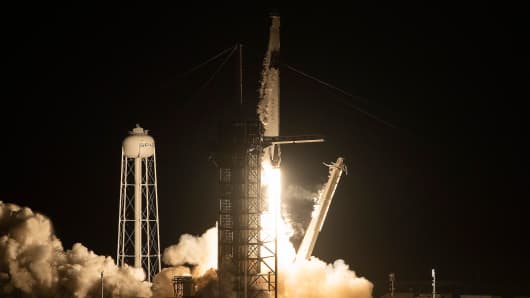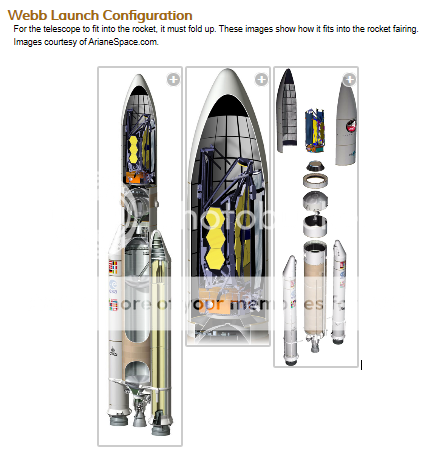The James Webb Space Telescope
Message boards :
Science (non-SETI) :
The James Webb Space Telescope
Message board moderation
Previous · 1 . . . 8 · 9 · 10 · 11 · 12 · 13 · Next
| Author | Message |
|---|---|
 Julie Julie Send message Joined: 28 Oct 09 Posts: 34053 Credit: 18,883,157 RAC: 18 
|
|
|
Michael Watson Send message Joined: 7 Feb 08 Posts: 1384 Credit: 2,098,506 RAC: 5 |
There is apparently every intention of making the Hubble Space Telescope last as long as possible. This makes sense considering the time, effort, and money already invested in it over the years for design, planning, construction, launching, and five maintenance missions. A commercial maintenance mission is being contemplated, for some time in the 2020s, now that the Space Shuttle is no longer available for such a task. The HST will de-orbit due to the effects of atmospheric friction, some time between 2028 and 2040. The variable here is solar activity. If the Sun is less than typically active in the years ahead, the HST can be expected the remain in orbit longer. If the Sun kicks up its activity above normal, it will come down sooner. The Sun's activity tends to swell the Earth's atmosphere, and increase friction. There appears to be a sense, now, that the Sun may be unusually quiet in the years ahead, so there are grounds for optimism about Hubble's longevity in orbit. |
 Byron Leigh Hatch @ team Carl Sagan Byron Leigh Hatch @ team Carl Sagan Send message Joined: 5 Jul 99 Posts: 4548 Credit: 35,667,570 RAC: 4 
|
Good post thank you. There is apparently every intention of making the Hubble Space Telescope last as long as possible. This makes sense considering the time, effort, and money already invested in it over the years for design, planning, construction, launching, and five maintenance missions. A commercial maintenance mission is being contemplated, for some time in the 2020s, now that the Space Shuttle is no longer available for such a task. would it possible or feasible to design a space mission to boost the Hubble space telescope telescope to a higher orbit? the reason for this: Scientists had hoped to operate Hubble at the same time as the James Webb Space Telescope i google this question and found this from 2015. Scientists had hoped to operate Hubble at the same time as the James Webb Space Telescope, currently planned for launch in late 2018. In spite of its giant 6.5-meter primary mirror, and its being advertised as a “successor†to Hubble, it is not a successor. Webb is optimized for infrared wavelengths extending just into the visible range (orange), while Hubble operates at ultraviolet and visible wavelengths, extending just into the near-infrared. The two instruments are complementary, with a slight overlap. There is no successor to Hubble; no comparably large space telescope designed to observe at visible or ultraviolet wavelengths is anywhere near launch. i guess it is a question of money . . . but if could get 8 or 10 industrial countries to fund at lest a fesability study ? the purpose of such a mission: Scientists had hoped to operate Hubble at the same time as the James Webb Space Telescope. Read more here: https://spacenews.com/op-ed-a-not-so-final-servicing-mission/ |
 Byron Leigh Hatch @ team Carl Sagan Byron Leigh Hatch @ team Carl Sagan Send message Joined: 5 Jul 99 Posts: 4548 Credit: 35,667,570 RAC: 4 
|
There is apparently every intention of making the Hubble Space Telescope last as long as possible. This makes sense considering the time, effort, and money already invested in it over the years for design, planning, construction, launching, and five maintenance missions. A commercial maintenance mission is being contemplated, for some time in the 2020s, now that the Space Shuttle is no longer available for such a task. i found some more information to save HST: Scientists had hoped to operate Hubble at the same time as the James Webb Space Telescope, currently planned for launch in late 2018. In spite of its giant 6.5-meter primary mirror, as i mentioned in last post: Possible commercial service missions #1 In terms of resources, the ability to carry cargo and to conduct spacewalks is essential. Excess propellant or a propulsion module is required for the reboost. We will soon have at least one spacecraft The SpaceX Falcon 9-launched Dragon v2, Falcon 9 launches Crew Dragon on key test flight by Jeff Foust — March 2, 2019 https://spacenews.com/falcon-9-launches-crew-dragon-on-key-test-flight/  Possible commercial service missions #2 As of 2017, the Trump Administration is considering a proposal by the Sierra Nevada Corporation to use a manned version of its: Sierra Nevada Corporation's Dream Chaser spacecraft:  to service Hubble some time in the 2020s both as a continuation of its scientific capabilities and as insurance against any malfunctions in the to-be-launched James Webb Space Telescope. https://en.wikipedia.org/wiki/Hubble_Space_Telescope#Possible_commercial_service_missions https://en.wikipedia.org/wiki/Sierra_Nevada_Corporation https://www.sncorp.com/what-we-do/dream-chaser-space-vehicle/ https://www.nasa.gov/missions/highlights/webcasts/shuttle/sts109/hubble-qa.html |
 Gary Charpentier Gary Charpentier  Send message Joined: 25 Dec 00 Posts: 30651 Credit: 53,134,872 RAC: 32 
|
I don't think the present orbit is the limiting factor. I think gyroscope life is the limiting factor. Also we don't have any spacecraft with a Canada arm to go up and grab it. It is what it is. |
 Byron Leigh Hatch @ team Carl Sagan Byron Leigh Hatch @ team Carl Sagan Send message Joined: 5 Jul 99 Posts: 4548 Credit: 35,667,570 RAC: 4 
|
I don't think the present orbit is the limiting factor. I think gyroscope life is the limiting factor. Also we don't have any spacecraft with a Canada arm to go up and grab it. It is what it is. Yes you are right Gary, as it says in the article - - Any future repair mission will most likely need to replace failed gyroscopes. The gyroscopes spin at 19,200 revolutions per minute on gas bearings to measure and counter telescope drift, providing an extremely still platform for observations. According to the European Space Agency, they are the best available, but having moving parts they are prone to failure. https://spacenews.com/op-ed-a-not-so-final-servicing-mission/ |
 Byron Leigh Hatch @ team Carl Sagan Byron Leigh Hatch @ team Carl Sagan Send message Joined: 5 Jul 99 Posts: 4548 Credit: 35,667,570 RAC: 4 
|
|
 Pierre A Renaud Pierre A Renaud Send message Joined: 3 Apr 99 Posts: 998 Credit: 9,101,544 RAC: 65 
|
Starting at 59m Dr Carol Christian (astrophysicist at the Space Telescope Science Institute) says money constraints, along with the much greater scientific potential of the JWT and WFIRST (along with the pressure of the scientific community), mean further maintenance mi$$ions to NASA's Hubble, manned or robotic, are improbable (unless a private sector initiative susprises us). Thanks for your link, Byron. Curious Droid's videos (like the one you provided below) are *very* comprehensive, both in terms of contents and perspectives. Can We Save Hubble and Where is the James Webb Space Telescope?    Apr 3, 1999 - May 3, 2020 Apr 3, 1999 - May 3, 2020
|
 Julie Julie Send message Joined: 28 Oct 09 Posts: 34053 Credit: 18,883,157 RAC: 18 
|
Can We Save Hubble and Where is the James Webb Space Telescope? I have heard that the Hubble stays in operation after the launch of the JWST. Probably until funds run out. rOZZ Music Pictures |
 Julie Julie Send message Joined: 28 Oct 09 Posts: 34053 Credit: 18,883,157 RAC: 18 
|
|
 Ernst Ernst Send message Joined: 6 Jul 19 Posts: 169 Credit: 262,003 RAC: 0 
|
I find it stimulating that we are all looking for a way off this Planet. :) á´¡á´‡ ᴅᴀʀᴇsá´€Ê á´€Ê™á´á´œá´› ᴛʜᴇ ᴘᴀsá´› ᴛʜᴀᴛ ɪᴛ ɪs ғɪɴɪᴛᴇ Êᴇᴛ á´¡á´‡ ᴅᴀʀᴇ É´á´á´› ʙᴇʟɪᴇᴠᴇ ᴛʜᴇ ғᴜᴛᴜʀᴇ ɪs. |
 Pierre A Renaud Pierre A Renaud Send message Joined: 3 Apr 99 Posts: 998 Credit: 9,101,544 RAC: 65 
|
James Webb's Eye in the Sky Aids Human Eyes with LASIK Tech | Space https://www.space.com/james-webb-technology-improve-human-vision.html LASIK: Laser-Assisted In-Situ Keratomileusis (vision correction laser surgery) I find it stimulating that we are all looking for a way off this Planet. :)The way things are going it looks that not putting all our eggs in the same basket seems to be one of the best ideas ever indeed :/    Apr 3, 1999 - May 3, 2020 Apr 3, 1999 - May 3, 2020
|
 Julie Julie Send message Joined: 28 Oct 09 Posts: 34053 Credit: 18,883,157 RAC: 18 
|
|
 William Rothamel William Rothamel Send message Joined: 25 Oct 06 Posts: 3756 Credit: 1,999,735 RAC: 4 
|
I find it stimulating that we are all looking for a way off this Planet. :) Where would we go and how would we get there ? |
 tullio tullio Send message Joined: 9 Apr 04 Posts: 8797 Credit: 2,930,782 RAC: 1 
|
The JWST has been fully assembled at the Northrop-Grumman plant in Redondo Beach, CA. It will undergo further testing. Launch is planned in 2021. Tullio |
rob smith  Send message Joined: 7 Mar 03 Posts: 22203 Credit: 416,307,556 RAC: 380 
|
And here's a link to the BBC article about the assembly https://www.bbc.co.uk/news/science-environment-49504866 Bob Smith Member of Seti PIPPS (Pluto is a Planet Protest Society) Somewhere in the (un)known Universe? |
 Byron Leigh Hatch @ team Carl Sagan Byron Leigh Hatch @ team Carl Sagan Send message Joined: 5 Jul 99 Posts: 4548 Credit: 35,667,570 RAC: 4 
|
And here's a link to the BBC article about the assembly thanks for that link Rob :) Launch Date: Webb will launch in 2021. i hope i can live to 2021 to see the Launch. Launch Location Webb will be launched from Arianespace's ELA-3 launch complex at European Spaceport located near Kourou, French Guiana. It is beneficial for launch sites to be located near the equator the spin of the Earth can help give an additional push. https://jwst.nasa.gov/content/about/launch.html https://www.jwst.nasa.gov/  |
 Julie Julie Send message Joined: 28 Oct 09 Posts: 34053 Credit: 18,883,157 RAC: 18 
|
|
 Julie Julie Send message Joined: 28 Oct 09 Posts: 34053 Credit: 18,883,157 RAC: 18 
|
|
 Julie Julie Send message Joined: 28 Oct 09 Posts: 34053 Credit: 18,883,157 RAC: 18 
|
|

©2024 University of California
SETI@home and Astropulse are funded by grants from the National Science Foundation, NASA, and donations from SETI@home volunteers. AstroPulse is funded in part by the NSF through grant AST-0307956.